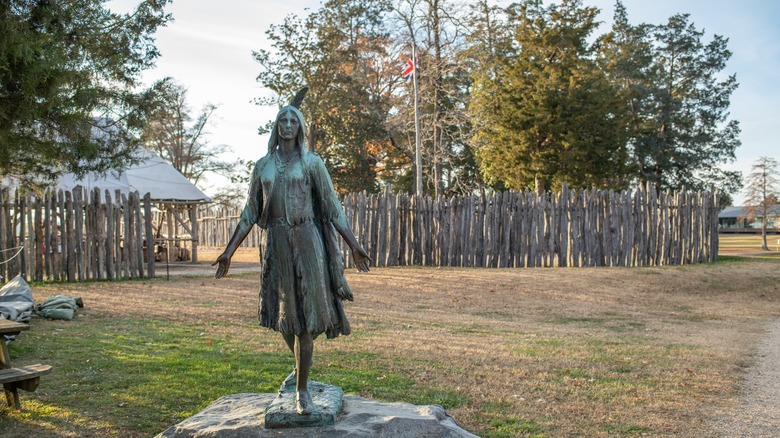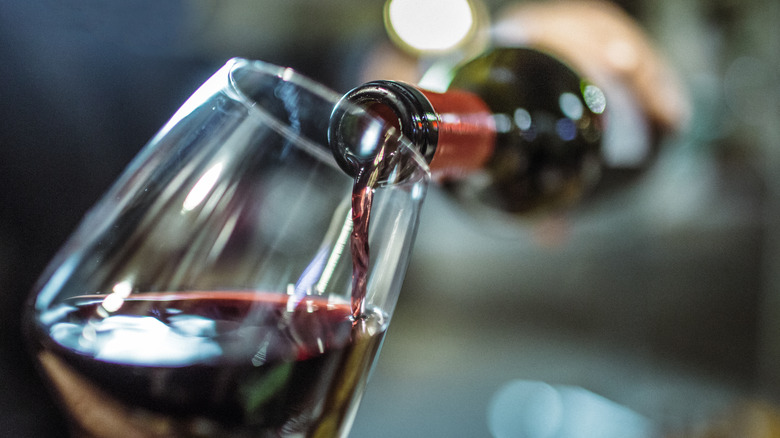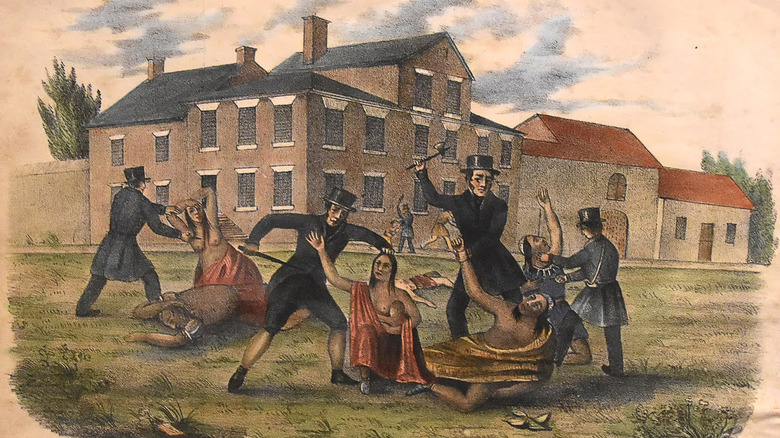The Tragic Way The British Used Wine To Poison Over 200 Native Americans At Once
So we all know that relationships between North American European settlers and Native American tribes weren't all that great, right? In less than 300 years — from the early 1600s to the late 1800s — Native Americans got beaten further back as colonists pushed west, particularly during the U.S.' Westward Expansion following the 1803 purchase of the Louisiana Territory from France.
The entire period from 1622 to the early 20th century contains what's called the "Indian Wars." Per History, this includes (deep breath) the Pequot War, the Beaver Wars, King Philip's War, Queen Anne's War, the Tuscarora War, the French and Indian War, endless Revolutionary War-era skirmishes with tribes like the Iroquois, Shawnee, Cherokee, Creek, and Potawatomi, the First, Second, and Third Seminole Wars, the Indian Removal Act and the Trail of Tears, the Black Hawk War, the Sand Creek Massacre, Red Cloud's War, the Battle of Little Bighorn, and on and on and on. And those are just the big historical blowouts. Get the picture?
The point is this: You might think to yourself, "Surely, amidst all this conflict, there couldn't be one atrocity that stands out." Well ... think again. Per Smithsonian Magazine, English soldiers propelled the centuries-long bloodbath with a scam so vile, so cartoonishly villainous, that it belongs to a cackling movie villain. On May 22, 1623, they passed along the gift of drink to Powhatan representatives during a prisoner return and peace talks. Up went the toast of wine, and down went 200 poisoned Powhatans.
A poisoned chalice at peace talks
Lifting a firearm during combat is one thing, but lifting a literal poisoned chalice during peace talks is another, grotesque betrayal entirely. And yet, perhaps the unnamed English troops of 1623 felt justified. Smithsonian Magazine says that Pamunkey leader Opechancanough went to modern-day West Point, Virginia to give back prisoners claimed in battle against the English in March 1622 the previous year. Opechancanough had conducted attacks that year in response to encroachment on native territory. And so the endless back-and-forth commenced, as 1622 marked the official beginning of the aforementioned, centuries-long Indian Wars.
But then, at that moment, Opechancanough returned English prisoners with the intent of initiating peace talks. He was the war chief of a group of Powhatan warriors, Powhatans being the collective name for members of a confederacy of more than 30 tribes. "Colonial America: A History to 1763" says that the English detachment responsible for poisoning him and his fellows planned so from the beginning, as the peace talks were a "ruse." They were part of a larger goal of "hoping to destroy" any and all tribesmen near the Jamestown settlement.
Per the Historical Marker Database, a memorial sign to the incident titled "Indians Poisoned at Peace Meeting" says that "the English called for a toast." When the Powhatans took ill, English soldiers pulled out their weapons and opened fire. And yet, Smithsonian Magazine explains that they were only partially successful — 200 tribesmen were poisoned and as many as 150 were injured, but Opechancanough himself survived.
The endless cycle of bloodshed
Nowadays, the 1949 Geneva Convention lays out post-World War II ground rules for what actions are prohibited during times of war. As the United Nations outlines, the Rome Statute of the International Criminal Court, Article 8, constitutes "employing poison or poisoned weapons" as a war crime — full stop. But even back in 1623 when English troops used a gift of wine to poison 200 Powhatans, folks knew that such actions were particularly low and despicable. Dutch philosopher and political theorist Hugo Grotius wrote extensively on what Stanford University describes as his "just war doctrine." Britannica summarizes this doctrine — laid out in full in Grotius' 1625 book "On the Laws of War and Peace" — as war being "justifiable only if a country faces imminent danger and the use of force is both necessary and proportionate to the threat." So poisoning people at peace talks and then pulling out guns to shoot them? That doesn't quite fit the standard of the time, or today's.
And just to bring the tragic irony full circle, there was absolutely no way that Powhatan war leader Opechancanough was going to trust European settlers after such a betrayal. He survived, and over 20 years later from 1644 to 1646 came back with a vengeance and slaughtered 500 colonists, as "Colonial America: A History to 1763" explains. He was captured and executed that last year, in 1646. And so the cycle of bloodshed persisted for almost another 300 years.
[Featured image by Unknown Author via Wikimedia Commons | Cropped and scaled]


